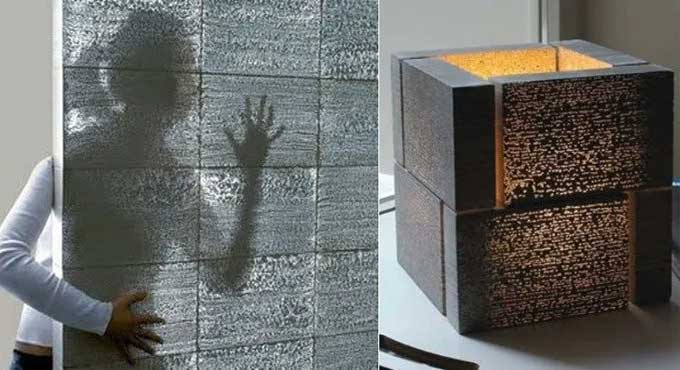
Translucent Concrete in Modern-day Construction

Using translucent concrete provides structural and aesthetic benefits while bringing in natural light. This innovative material can create modern and striking architectural projects while conserving energy and increasing safety.
What do you mean by Translucent Concrete?
Translucent concrete, also known as light transmitting concrete, is a type of concrete that allows light to pass through it. It is made by embedding optical fibres or other transparent materials, such as resin or glass, within the concrete mixture. These materials are carefully placed within the concrete in a pattern that allows light to be transmitted through the solid material.
The result is a material that looks and behaves like traditional concrete but has the added benefit of transmitting light. Translucent concrete can be used in a variety of applications, including architectural features, building facades, and decorative elements. It can also be used in situations where natural light is limited or where privacy is desired without sacrificing light.
What are some of the benefits of using translucent concrete?
Translucent concrete, also known as light-transmitting concrete or translucent cementitious composite, is a type of concrete that allows light to pass through it. Here are some potential benefits of using translucent concrete:
1. Aesthetics: Translucent concrete can be used to create visually stunning architectural designs, both indoors and outdoors. It can be used in a variety of ways, including walls, floors, and even furniture.
2. Energy efficiency: Since translucent concrete allows natural light to pass through it, it can reduce the need for artificial lighting, thereby reducing energy consumption and costs.
3. Durability: Translucent concrete is just as durable as traditional concrete and has the same load-bearing capabilities. It can also withstand weathering and other environmental factors.
4. Safety: Translucent concrete can be used to create illuminated walkways, stairs, and other surfaces, making them safer to use at night or in low-light conditions.
5. Acoustic insulation: Translucent concrete can be used as a sound barrier, blocking noise pollution while still allowing light to pass through.
6. Versatility: Translucent concrete can be customized to different levels of translucency, depending on the desired effect. This allows for a range of design possibilities and applications.
7. Sustainability: Translucent concrete can be made using sustainable materials, such as recycled glass, and can also contribute to a building's sustainability by reducing energy consumption.
8. Low maintenance: Translucent concrete is low maintenance and requires no special cleaning or upkeep.
9. Innovative technology: The development of translucent concrete has led to the creation of new technologies and techniques that can be applied to other areas of construction.
10. Creative expression: Translucent concrete can be used to express creativity and innovation in architecture, enabling designers to create structures that are both functional and visually appealing.
Transparent concrete is a potential material for future design and construction because it offers a variety of advantages, including aesthetic appeal, energy efficiency, and sustainability.
How can you use Translucent Concrete in Construction?
Here are some ways that translucent concrete can be used in construction:
1. Decorative purposes: Translucent concrete can be used to create stunning decorative features such as walls, floors, and ceilings. The material allows light to pass through, creating a unique and visually appealing effect.
2. Lighting: Translucent concrete can be used to create light fixtures or other lighting elements. The material can be formed into various shapes and designs, and the light transmitted through the concrete creates a soft and diffused glow.
3. Signage: Translucent concrete can be used to create signs that are visible during the day and night. The material can be formed into letters or logos and lit from behind, creating a striking and eye-catching effect.
4. Energy efficiency: Translucent concrete can be used in building envelopes to allow natural light into a space, reducing the need for artificial lighting and potentially reducing energy costs.
5. Privacy: Translucent concrete can be used in areas where privacy is desired, such as a bathroom or shower walls. The material allows light to pass through while still providing a degree of privacy.
It is important to note that while translucent concrete can be a visually striking and unique material, it may not be suitable for all applications. The material is relatively new and may not have a proven track record for long-term durability and performance in certain situations.
It is always important to consult with a professional before specifying a new and innovative material in a construction project.
What are some good alternatives for Translucent Concrete?
Using translucent concrete as a building material can create a striking visual effect, as light passes through it. You have several options to choose from if you want an alternative to translucent concrete. The following are some examples:
Glass Blocks: Glass blocks are a classic alternative to translucent concrete. They allow light to pass through while still providing privacy and insulation.
Fiberglass Panels: Fiberglass panels are lightweight, durable, and can be made in a variety of colours and patterns. They are also easy to install and can be used in a variety of applications, including walls, ceilings, and floors.
To learn more, watch the following video tutorial.
Video Source: Grey Element Projects
Polycarbonate Panels: Polycarbonate panels are similar to fiberglass panels but are even more durable and resistant to impact. They are frequently employed in commercial and industrial settings.
Translucent Stone: Some natural stones, such as alabaster and onyx, are naturally translucent and can be used as an alternative to translucent concrete. They can be cut into thin slabs and backlit to create a stunning effect.
Acrylic Panels: Acrylic panels are lightweight and durable and can be made in a variety of colours and patterns. They are also resistant to UV rays, making them a good option for outdoor applications.
Translucent Fabric: Translucent fabric can be used to create a soft, diffused light effect. It can be stretched over a frame or used as a curtain to create a unique visual effect.


